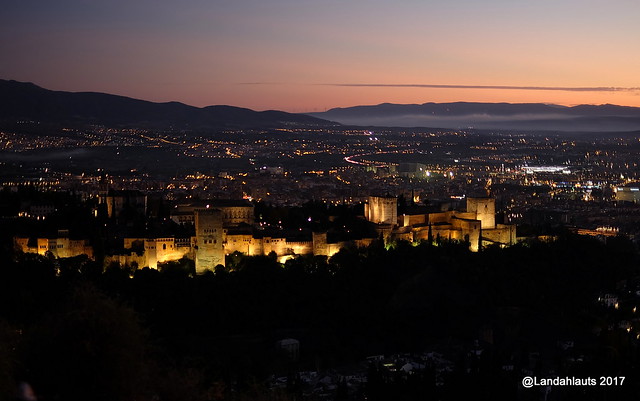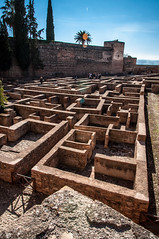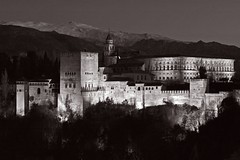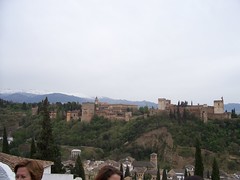Alhambra
The Alhambra (English: /ælˈhæmbrə/, Spanish: [aˈlambɾa]; Arabic: الْحَمْرَاء) is a palace and fortress complex located in Granada, Andalusia, Spain. It is one of the most famous monuments of Islamic architecture and one of the best-preserved palaces of the historic Islamic world, in addition to containing notable examples of Spanish Renaissance architecture.
The complex was begun in 1238 by Muhammad I Ibn al-Ahmar, the first Nasrid emir and founder of the Emirate of Granada, the last Muslim state of Al-Andalus. It was built on the Sabika hill, an outcrop of the Sierra Nevada which had been the site of earlier fortresses and of the 11th-century palace of Samuel ibn Naghrillah. Later Nasrid rulers continuously modified the site. The most significant construction campaigns, which gave the royal palaces much of their definitive character, took place in the 14th century during the reigns of Yusuf I and Muhammad V. After the conclusion of the Christian Reconquista in 1492, the site became the Royal Court of Ferdinand and Isabella (where Christopher Columbus received royal endorsement for his expedition), and the palaces were partially altered. In 1526, Charles V commissioned a new Renaissance-style palace in direct juxtaposition with the Nasrid palaces, but it was left uncompleted in the early 17th century. After being allowed to fall into disrepair for centuries, with its buildings occupied by squatters, the Alhambra was rediscovered following the defeat of Napoleon I, whose troops destroyed parts of the site. The rediscoverers were first British intellectuals and then other American and Northern European Romantic travelers. The most influential of them was Washington Irving, whose Tales of the Alhambra (1832) brought international attention to the site. The Alhambra was one of the first Islamic monuments to become the object of modern scientific study and has been the subject of numerous restorations since the 19th century. It is now one of Spain's major tourist attractions and a UNESCO World Heritage Site.
During the Nasrid era, the Alhambra was a self-contained city separate from the rest of Granada below. It contained most of the amenities of a Muslim city such as a Friday mosque, hammams (public baths), roads, houses, artisan workshops, a tannery, and a sophisticated water supply system. As a royal city and citadel, it contained at least six major palaces, most of them located along the northern edge where they commanded views over the Albaicín quarter. The most famous and best-preserved are the Mexuar, the Comares Palace, the Palace of the Lions, and the Partal Palace, which form the main attraction to visitors today. The other palaces are known from historical sources and from modern excavations. At the Alhambra's western tip is the Alcazaba fortress. Multiple smaller towers and fortified gates are also located along the Alhambra's walls. Outside the Alhambra walls and located nearby to the east is the Generalife, a former Nasrid country estate and summer palace accompanied by historic orchards and modern landscaped gardens.
The architecture of the Nasrid palaces reflects the tradition of Moorish architecture developed over previous centuries. It is characterized by the use of the courtyard as a central space and basic unit around which other halls and rooms were organized. Courtyards typically had water features at their center, such as a reflective pool or a fountain. Decoration was focused on the inside of the building and was executed primarily with tile mosaics on lower walls and carved stucco on the upper walls. Geometric patterns, vegetal motifs, and Arabic inscriptions were the main types of decorative motifs. Additionally, "stalactite"-like sculpting, known as muqarnas, was used for three-dimensional features like vaulted ceilings.
Etymology
Alhambra derives from the Arabic (, Arabic: [alħamˈraːʔ]), meaning (f), the complete form of which was "the red fortress (qalat)". The "Al-" in "Alhambra" means "the" in Arabic, but this is ignored in general usage in both English and Spanish, where the name is normally given the definite article. The reference to the colour "red" in the name is due to the reddish colour of its walls, which were constructed of rammed earth. The reddish colour comes from the iron oxide in the local clay used for this type of construction.
History
Origins and early history
The evidence for a Roman presence is unclear but archeologists have found remains of ancient foundations on the Sabika hill. A fortress or citadel, probably dating from the Visigothic period, existed on the hill in the 9th century. The first reference to the Qal‘at al-Ḥamra was during the battles between the Arabs and the Muladies during the rule of ‘Abdallah ibn Muhammad (r. 888–912). According to surviving documents from the era, the red castle was quite small, and its walls were not capable of deterring an army intent on conquering. The first reference to came in lines of poetry attached to an arrow shot over the ramparts, recorded by Ibn Hayyan (d. 1076):
At the beginning of the 11th century, the region of Granada was dominated by the Zirids, a Sanhaja Berber group and offshoot of the Zirids who ruled parts of North Africa. When the Caliphate of Córdoba collapsed after 1009 and the Fitna (civil war) began, the Zirid leader Zawi ben Ziri established an independent kingdom for himself, the Taifa of Granada. The Zirids built their citadel and palace, known as the al-Qaṣaba al-Qadīma ("Old Citadel" or "Old Palace"), on the hill now occupied by the Albaicín neighborhood. It was connected to two other fortresses on the Sabika and Mauror hills to the south. On the Darro River, between the Zirid citadel and the Sabika hill, was a sluice gate called Bāb al-Difāf ("Gate of the Tambourines"), which could be closed to retain water if needed. This gate was part of the fortification connecting the Zirid citadel with the fortress on the Sabika hill and it also formed part of a coracha (from Arabic qawraja), a type of fortification allowing soldiers from the fortress to access the river and bring back water even during times of siege. The Sabika hill fortress, also known as al-Qasaba al-Jadida ("the New Citadel"), was later used for the foundations of the current Alcazaba of the Alhambra. Under the Zirid kings Habbus ibn Maksan and Badis, the most powerful figure in the kingdom was the Jewish administrator known as Samuel ha-Nagid (in Hebrew) or Isma'il ibn Nagrilla (in Arabic). Samuel built his own palace on the Sabika hill, possibly on the site of the current palaces, although nothing remains of it. It reportedly included gardens and water features.
Nasrid period
The period of the Taifa kingdoms, during which the Zirids ruled, came to an end with the conquest of al-Andalus by the Almoravids from North Africa during the late 11th century. In the mid-12th century they were followed by the Almohads. After 1228 Almohad rule collapsed and local rulers and factions emerged again across the territory of Al-Andalus. With the Reconquista in full swing, the Christian kingdoms of Castile and Aragon – under kings Ferdinand III and James I, respectively – made major conquests across al-Andalus. Castile captured Cordoba in 1236 and Seville in 1248. Meanwhile, Ibn al-Ahmar (Muhammad I) established what became the last and longest reigning Muslim dynasty in the Iberian peninsula, the Nasrids, who ruled the Emirate of Granada. Ibn al-Ahmar was a relatively new political player in the region and likely came from a modest background, but he was able to win the support and consent of multiple Muslim settlements under threat from the Castilian advance. Upon settling in Granada in 1238, Ibn al-Ahmar initially resided in the old citadel of the Zirids on the Albaicin hill, but that same year he began construction of the Alhambra as a new residence and citadel. According to an Arabic manuscript since published as the Anónimo de Madrid y Copenhague,
During the reign of the Nasrid Dynasty, the Alhambra was transformed into a palatine city, complete with an irrigation system composed of aqueducts and water channels that provided water for the complex and for other nearby countryside palaces such as the Generalife. Previously, the old fortresses on the hill had been dependent on rainwater collected from the cistern near the Alcazaba and on what could be brought up from the Darro River below. The creation of the Sultan's Canal , which brought water from the mountains to the east, solidified the identity of the Alhambra as a palace-city rather than a defensive and ascetic structure. This first hydraulic system was expanded afterwards and included two long water channels and several sophisticated elevation devices to bring water onto the plateau.
Later Nasrid rulers after Ibn al-Ahmar continuously modified the site. Along with the fragile materials themselves, which needed regular repairs, this makes the exact chronology of its development difficult to determine. The only elements preserved from the time of Ibn al-Ahmar are some of the fortification walls, particularly the Alcazaba at the western end of the complex. Ibn al-Ahmar did not have time to complete any major new palaces and he may have initially lived in one of the towers of the Alcazaba, before later moving to a modest house on the site of the current Palace of Charles V. The oldest major palace for which some remains have been preserved is the structure known as the Palacio del Partal Alto, in an elevated location near the center of the complex, which probably dates from the reign of Ibn al-Ahmar's son, Muhammad II (r. 1273–1302). To the south was the Palace of the Abencerrajes, and to the east was another private palace, known as the Palace of the …
Looking for places related to Alhambra?
Those are other destinations to find places related to Alhambra:
- Alhambra
- Sacromonte
- Granada Cathedral
- Park Federico Garcí…
- Albayzín
- Royal Chapel
- El Bañuelo
- Jardín Botánico de …
- Gate of the Pomegra…
- Arc of Elvira
- Iglesia de San Gil …
- Estación
- Palacio de Abrantes
- Mezquita Mayor
- Casa del Chapiz
- Madrasah
- Puerta Monaita
- Castril Palace
- Annunciation Cathed…
- Archivo de la Real …
- Puerta de Fajalauza
- Hospital Universita…
- Realejo-San Matías
- Archaeological Muse…
























